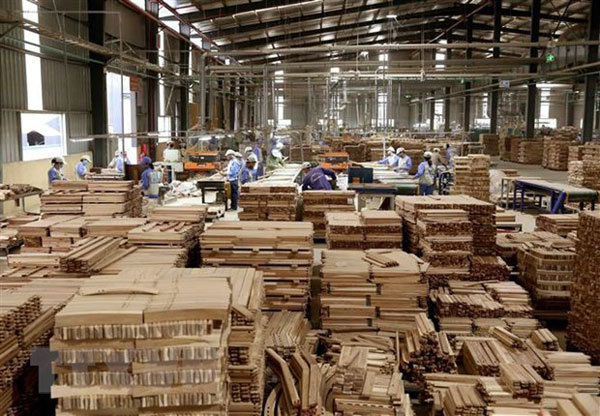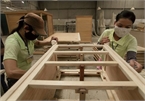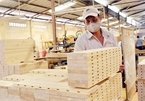and some wood processing businesses have so many orders while they are in short of workers to complete them, according to the Vietnam Timber and Forest Product Association (Vietforest).
 |
| Producing wooden products for export to EU market of WOODSLAND Tuyen Quang Joint Stock Company. — VNA/VNS Photo Vu Sinh |
The wood industry has consistently maintained two-digit growth rates in recent years, but the pandemic caused negative growth in the second quarter of 2020.
Exports of wood products to key markets such as the US, China, South Korea, Japan and the EU sharply fell from April to June and many factories had to temporarily close due to a lack of orders, materials and capital.
However, once the pandemic was basically controlled in July, countries started to restore production. Wood businesses resumed production with demand for wood furniture up significantly.
The efforts of local producers have reaped positive results as the export value of timber and non-timber products in August topped $1 billion. In the first 10 months of the year, wood product exports reached $9.6 billion, up 12.4 per cent from the same period last year.
Do Xuan Lap, Vietforest’s chairman, said the market has faced fluctuations due to COVID-19, but domestic wood producers have not waited for customers and have sought new sales channels.
Nguyen Chanh Phuong, vice chairman cum general secretary of the Handicrafts and Wood Industry Association of HCM City (HAWA), said since exhibitions and fairs were halted during the pandemic, the association sought orders online and digitised exhibitions.
The HAWA Online Platform for Exhibition (HOPE), which connects Vietnamese wood processing and furniture firms with international and local buyers, was launched in August.
HOPE features images of 360-degree showrooms, factories and workshops, a 3D product catalogue, social apps to enable 24/7 interaction between exhibitors and visitors, digital marketing, live events, and more.
Phuong said technology has brought opportunities but takes time for the administration. The contactless economy creates lower-cost exposure opportunities that can understand customers better, and turn them into projects to boost business operation.
Dien Quang Hiep from the Binh Duong Furniture Association (BIFA) said COVID-19 has been a test for all industries, including the wood sector.
The pandemic showed local businesses were not prepared for such situations and in the first two quarters of 2020, most firms in the wood industry faced difficulties.
However, as people were stuck at home due to the pandemic, the demand for home furniture increased, as did the number of customers shopping online.
This led to wood producers promoting connections online through global online sales channels such as Alibaba and Amazon. The BIFA signed deals with representative offices of these channels in Vietnam to promote online sales.
The foreign market has also increased purchases and some importers have shifted their purchases from the Chinese market to Vietnam.
These factors have helped Vietnam’s wooden furniture export market almost completely recover and some factories don't even have the capacity for new orders. Many companies in the furniture manufacturing industry are struggling to recruit more workers to produce in time to ensure export orders increase again.
With the rapid recovery of businesses in the wood industry, Lap also said the Government’s policies gave timely support to businesses during the peak of the pandemic.
The impact of COVID-19 showed Vietnam’s current wooden furniture export supply chains have not been good, depending on imported raw materials.
However, they were quickly linked together, minimising dependence from outside. Since then, businesses have offered products such as kitchen cabinets and bathroom cabinets, creating a breakthrough for Vietnamese firms.
Earlier, export wooden furniture was mainly outdoor furniture. Now businesses have identified products such as kitchen cabinets, bathroom cabinets and decorative boards as important.
In the first nine months of 2020, kitchen cabinets and bathroom cabinets alone achieved an export value of nearly $1 billion, up more than 80 per cent over the same period in 2019.
Ha Cong Tuan, deputy minister of Agriculture and Rural Development, said the results have shown that local firms have creativity in administration, negotiations and developing new products.
He said the wood industry should improve product competitiveness and increase productivity for sustainable development.
The deputy minister said associations and enterprises in the wood processing and exporting industry need to have a good understanding of Government Decree 102/2020/ND-CP on Vietnam’s timber legality assurance system.
The implementation of this decree would not only help reduce non-tariff barriers on traceability and accountability to the EU market but also create a positive reputation for Vietnam’s wood industry in other markets.
Hiep said businesses should work together in addition to investing machines and technologies.
To build a whole business community, it is essential to have policies from the State to establish a concentrated specialised industrial park. After that, businesses could co-operate to create specialisations in production, helping reduce investment and transportation costs, he added. VNS

Vietnam likely to gain export target for timber and wooden products this year: experts
Experts believe Viet Nam this year will reach its export target for timber and wooden products at US$12 billion, despite the impact of the COVID-19...

New strategies required to set deeper roots for wood industry
To expand Vietnam’s wood industry sustainably, its development strategy must not only focus on the policies of importing countries but also domestic priorities.